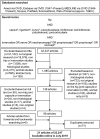Innervation of the hip joint capsular complex: A systematic review of histological and immunohistochemical studies and their clinical implications for contemporary treatment strategies in total hip arthroplasty
- PMID: 32101545
- PMCID: PMC7043757
- DOI: 10.1371/journal.pone.0229128
Innervation of the hip joint capsular complex: A systematic review of histological and immunohistochemical studies and their clinical implications for contemporary treatment strategies in total hip arthroplasty
Abstract
The hip joint capsule contributes to the stability of the hip joint and lower extremity, yet this structure is incised and often removed during total hip arthroplasty (THA). Increasing incidence of osteoarthritis is accompanied by a dramatic rise in THAs over the last few decades. Consequently, to improve this treatment, THA with capsular repair has evolved. This partial restoration of physiological hip stability has resulted in a substantial reduction in post-operative dislocation rates compared to conventional THA without capsular repair. A further reason for the success of this procedure is thought to be the preservation of the innervation of the capsule. A systematic review of studies investigating the innervation of the hip joint capsular complex and pseudocapsule with histological techniques was performed, as this is not well established. The literature was sought from databases Amed, Embase and Medline via OVID, PubMed, ScienceDirect, Scopus and Web of Science; excluding articles without a histological component and those involving animals. A total of 21 articles on the topic were identified. The literature indicates two primary outcomes and potential clinical implications of the innervation of the capsule. Firstly, a role in the mechanics of the hip joint, as mechanoreceptors may be present in the capsule. However, the nomenclature used to describe the distribution of the innervation is inconsistent. Furthermore, the current literature is unable to reliably confirm the proprioceptive role of the capsule, as no immunohistochemical study to date has reported type I-III mechanoreceptors in the capsule. Secondly, the capsule may play a role in pain perception, as the density of innervation appears to be altered in painful individuals. Also, increasing age may indicate requirements for different strategies to surgically manage the hip capsule. However, this requires further study, as well as the role of innervation according to sex, specific pathology and other morphometric variables. Increased understanding may highlight the requirement for capsular repair following THA, how this technique may be developed and the contribution of the capsule to joint function and stability.
Conflict of interest statement
The authors have declared that no competing interests exist.
Figures


Similar articles
-
A systematic review and meta-analysis of the hip capsule innervation and its clinical implications.Sci Rep. 2021 Mar 5;11(1):5299. doi: 10.1038/s41598-021-84345-z. Sci Rep. 2021. PMID: 33674621 Free PMC article.
-
[The impact of capsular repair on the dislocation rate after primary total hip arthroplasty: a retrospective analysis of 1972 cases].Z Orthop Unfall. 2014 Apr;152(2):130-43. doi: 10.1055/s-0034-1368209. Epub 2014 Apr 23. Z Orthop Unfall. 2014. PMID: 24760453 German.
-
Importance of hip capsular repair in total hip arthroplasty (THA) via the posterior lateral approach: a five year retrospective cohort study.Int Orthop. 2024 Oct;48(10):2567-2577. doi: 10.1007/s00264-024-06293-3. Epub 2024 Aug 30. Int Orthop. 2024. PMID: 39212693
-
Should the Capsule Be Repaired or Plicated After Hip Arthroscopy for Labral Tears Associated With Femoroacetabular Impingement or Instability? A Systematic Review.Arthroscopy. 2018 Jan;34(1):303-318. doi: 10.1016/j.arthro.2017.06.030. Epub 2017 Aug 31. Arthroscopy. 2018. PMID: 28866345
-
Surgical technique: a simple technique for closing the capsule of the hip in posterolateral approach total hip arthroplasty.BMC Musculoskelet Disord. 2025 Feb 28;26(1):207. doi: 10.1186/s12891-025-08429-x. BMC Musculoskelet Disord. 2025. PMID: 40022105 Free PMC article.
Cited by
-
Comparison of Locations and Frequencies of Referred Pain in Pediatric Hip Disorders: A Retrospective Study.Cureus. 2025 Feb 18;17(2):e79214. doi: 10.7759/cureus.79214. eCollection 2025 Feb. Cureus. 2025. PMID: 40125114 Free PMC article.
-
Deep posterior gluteal compartment block for regional anaesthesia of the posterior hip: a proof-of-concept pilot study.BJA Open. 2023 Feb 15;5:100127. doi: 10.1016/j.bjao.2023.100127. eCollection 2023 Mar. BJA Open. 2023. PMID: 37587997 Free PMC article.
-
Comparison of the efficacy of pericapsular nerve group block (PENG) block versus suprainguinal fascia iliaca block (SFIB) in total hip arthroplasty: A randomized control trial.Indian J Anaesth. 2023 Apr;67(4):364-369. doi: 10.4103/ija.ija_311_22. Epub 2023 Apr 10. Indian J Anaesth. 2023. PMID: 37303868 Free PMC article.
-
Reliability of hip joint position sense tests using a clinically applicable measurement tool in elderly participants with unilateral hip osteoarthritis.Sci Rep. 2022 Jan 10;12(1):376. doi: 10.1038/s41598-021-04288-3. Sci Rep. 2022. PMID: 35013488 Free PMC article.
-
A systematic review and meta-analysis of the hip capsule innervation and its clinical implications.Sci Rep. 2021 Mar 5;11(1):5299. doi: 10.1038/s41598-021-84345-z. Sci Rep. 2021. PMID: 33674621 Free PMC article.
References
-
- NJR. National Joint Registry 14th Annual Report 2017. 2017.
-
- NZOA. New Zealand Joint Registry 17 year Report. 2016;0–170.
Publication types
MeSH terms
LinkOut - more resources
Full Text Sources
Medical

